Related Research Articles

The Apple II series of microcomputers was initially designed by Steve Wozniak, manufactured by Apple Computer, and launched in 1977 with the Apple II model that gave the series its name. It was followed by the Apple II Plus, Apple IIe, Apple IIc, and Apple IIc Plus, with the 1983 IIe being the most popular. The name is trademarked with square brackets as Apple ][, then, beginning with the IIe, as Apple //. In terms of ease of use, features, and expandability, the Apple II was a major advancement over its predecessor, the Apple I, a limited-production bare circuit board computer for electronics hobbyists.
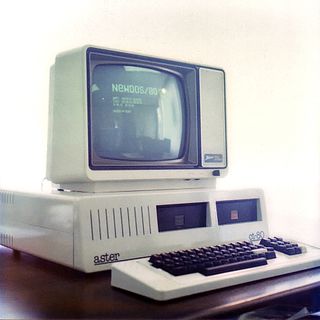
The Aster CT-80 is a 1982 personal computer developed by the small Dutch company MCP, was sold in its first incarnation as a kit for hobbyists. Later it was sold ready to use. It consisted of several Eurocard PCB's with DIN 41612 connectors, and a backplane all based on a 19-inch rack configuration. It was the first commercially available Dutch personal/home computer. The Aster computer could use the software written for the popular Tandy TRS-80 computer while fixing many of the problems of that computer, but it could also run CP/M software, with a large amount of free memory Transient Program Area, (TPA) and a full 80×25 display, and it could be used as a Videotext terminal. Although the Aster was a clone of the TRS-80 Model I it was in fact more compatible with the TRS-80 Model III and ran all the software of these systems including games. It also had a built-in speaker which was compatible with such games software.

The Dragon 32 and Dragon 64 are home computers that were built in the 1980s. The Dragons are very similar to the TRS-80 Color Computer, and were produced for the European market by Dragon Data, Ltd., initially in Swansea, Wales before moving to Port Talbot, Wales and by Eurohard S.A. in Casar de Cáceres, Spain, and for the US market by Tano Corporation of New Orleans, Louisiana. The model numbers reflect the primary difference between the two machines, which have 32 and 64 kilobytes of RAM, respectively.

The Jupiter Ace by Jupiter Cantab was a British home computer released in 1982. The Ace differed from other microcomputers of the time in that its programming environment used Forth instead of the more popular BASIC. This difference, along with limited available software and poor character based graphic display, limited sales and the machine was not a success.

The Atari 8-bit computers, formally launched as the Atari Home Computer System, are a series of home computers introduced by Atari, Inc., in 1979 with the Atari 400 and Atari 800. The architecture is designed around the 8-bit MOS Technology 6502 CPU and three custom coprocessors which provide support for sprites, smooth multidirectional scrolling, four channels of audio, and other features. The graphics and sound are more advanced than most of its contemporaries, and video games are a key part of the software library. The 1980 first-person space combat simulator Star Raiders is considered the platform's killer app.

The Commodore PET is a line of personal computers produced starting in 1977 by Commodore International. A single all-in-one case combines a MOS Technology 6502 microprocessor, Commodore BASIC in read-only memory, keyboard, monochrome monitor, and, in early models, a cassette deck.

The Nascom 1 and 2 were single-board computer kits issued in the United Kingdom in 1977 and 1979, respectively, based on the Zilog Z80 and including a keyboard and video interface, a serial port that could be used to store data on a tape cassette using the Kansas City standard, and two 8-bit parallel ports. At that time, including a full keyboard and video display interface was uncommon, as most microcomputer kits were then delivered with only a hexadecimal keypad and seven-segment display. To minimize cost, the buyer had to assemble a Nascom by hand-soldering about 3,000 joints on the single circuit board. Later on, a pre-built, cased machine named Nascom 3 was available; this used the Nascom 2 board.
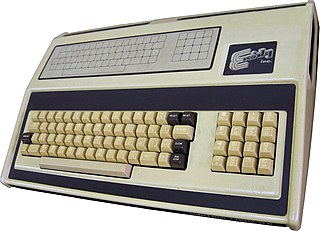
The Sorcerer is a home computer system released in 1978 by the video game company Exidy, of Sunnyvale, California, and later marketed as a small business computer system under their Exidy Systems subsidiary. Based on the Zilog Z80 and the general layout of the emerging S-100 standard, the Sorcerer was comparatively advanced when released, and especially when compared to the contemporary and more commercially successful Commodore PET and TRS-80. Sorcerer sales worldwide, of around 20,000 units, is comparable to the TRS-80 model II, both targetting Small or Home Business Computer users. The overall concept originated with Paul Terrell, formerly of the Byte Shop, a pioneering computer store. Coincidentally, the TRS-80 model I was designed by Steve Leininger, a former Byte Shop employee.

The SAM Coupé is an 8-bit British home computer manufactured by Miles Gordon Technology (MGT), based in Swansea in the United Kingdom and released in December 1989.

The VTech Laser 200 is an 8-bit home computer from 1983, also sold as the Salora Fellow, the Seltron 200 in Hungary & Italy, the Smart-Alec Jr. by Dynasty Computer Corporation in Dallas, Texas for the USA, the Texet TX8000A, the Dick Smith VZ 200, and the VTech VZ 200.

MicroBee was a series of networkable home computers by Applied Technology, which became publicly listed company MicroBee Systems Limited soon after its release. The original Microbee computer was designed in Australia by a team including Owen Hill and Matthew Starr.

The Apricot Portable was a personal computer manufactured by ACT Ltd., and was released to the public in November 1984. It was ACT's first attempt at manufacturing a portable computer, which were gaining popularity at the time. Compared to other portable computers of its time like the Compaq Portable and the Commodore SX-64, the Apricot Portable was the first system to have an 80-column and 25-line LCD screen and the first with a speech recognition system.

The Tangerine Microtan 65 was a 6502-based single board microcomputer, first sold in 1979, that could be expanded into, what was for its day, a comprehensive and powerful system. The design became the basis for what later became the Oric Atmos and later computers. Those later machines have similar keyboard addressing and tape I/O as the Microtan 65. The Microtan 65 has a hardware single step function that can be used for debugging software in both ROM and RAM. The computer was available as ready-built boards or as kits consisting of board and components requiring soldering together.
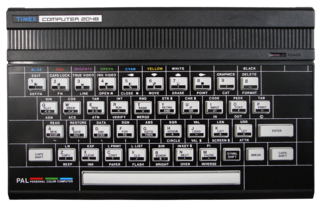
The Timex Computer 2048 or TC 2048 is a 1984 computer developed by Timex Portugal, at the time part of Timex Sinclair. It was based on the Timex Sinclair 2048 prototype, with a similar redesign case, composite video output, Kempston joystick interface, and additional video modes, while being highly compatible with the Sinclair ZX Spectrum computer.

The Research Machines 380Z was an early 8-bit microcomputer produced by Research Machines in Oxford, England, from 1977 to 1985.
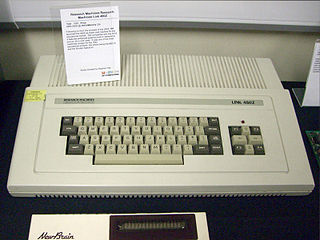
The LINK 480Z was an 8-bit microcomputer produced by Research Machines Limited in Oxford, England, during the early 1980s.

The TRS-80 Model II is a computer system launched by Tandy in October 1979, and targeted at the small-business market. It is not an upgrade of the original TRS-80 Model I, but a new system.

The APC was a series of business microcomputers released outside of Japan by the NEC Corporation. The series comprised the APC, the APC II and APC III, international versions of models from the Japanese NEC N5200 series(jp).
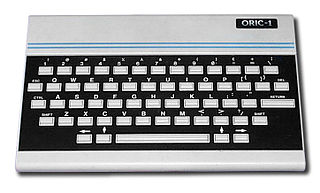
Oric was a brand of home computers sold in the 1980s by Tangerine Computer Systems. Tangerine was based in the United Kingdom and sold their computers primarily in Europe. All computers in the Oric line were based on the MOS Technology 6502A microprocessor.

The Olivetti M20 is a Zilog Z8000 based computer designed and released by Olivetti in 1982. Although it offered good performance, it suffered from a lack of software due to its use of the Z8000 processor and custom operating system, PCOS. The company introduced the IBM PC compatible Olivetti M24 in 1983 and the M20 line was phased out.
References
- ↑ J H Adams (1979-01-01). PSI Comp 80 from Wireless World 1979-80.
PSI 2020